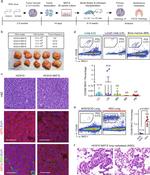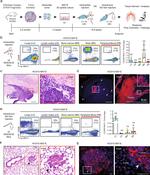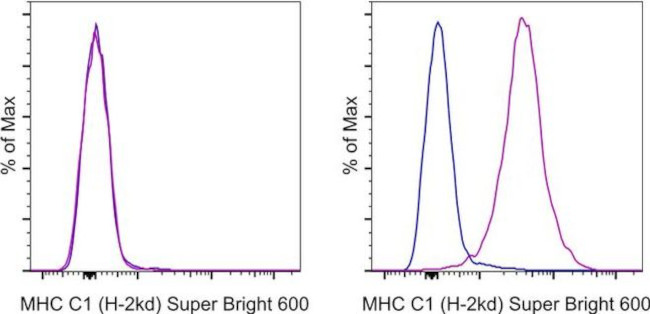Invitrogen
MHC Class I (H-2Kd) Monoclonal Antibody (SF1-1.1.1), Super Bright™ 600, eBioscience™
FIGURE: 1 / 7
MHC Class I (H-2Kd) Antibody (63-5957-82) in Flow







Product Details
63-5957-82
Species Reactivity
Published species
Host/Isotype
Recommended Isotype Control
Class
Type
Clone
Conjugate
Excitation/Emission Max
Form
Concentration
Purification
Storage buffer
Contains
Storage conditions
Shipping conditions
RRID
Product Specific Information
Description: This SF1-1.1.1 monoclonal antibody reacts with the H-2Kd MHC class I alloantigen. H-2Kd is involved in antigen presentation to T cells expressing CD3/TCR and CD8. Reactivity to other haplotypes (e.g. b, j, k, p, q, s, and v) has not been observed.
Applications Reported: This SF1-1.1.1 antibody has been reported for use in flow cytometric analysis.
Applications Tested: This SF1-1.1.1 antibody has been tested by flow cytometric analysis of mouse splecnocytes. This can be used at less than or equal to 0.5 µg per test. A test is defined as the amount (µg) of antibody that will stain a cell sample in a final volume of 100 µL. Cell number should be determined empirically but can range from 10^5 to 10^8 cells/test. It is recommended that the antibody be carefully titrated for optimal performance in the assay of interest.
Super Bright 600 is a tandem dye that can be excited with the violet laser line (405 nm) and emits at 600 nm. We recommend using a 610/20 bandpass filter. Please make sure that your instrument is capable of detecting this fluorochrome.
When using two or more Super Bright dye-conjugated antibodies in a staining panel, it is recommended to use Super Bright Complete Staining Buffer (Product # SB-4401) to minimize any non-specific polymer interactions. Please refer to the datasheet for Super Bright Staining Buffer for more information.
Light sensitivity: This tandem dye is sensitive to photo-induced oxidation. Please protect this vial and stained samples from light.
Fixation: Samples can be stored in IC Fixation Buffer (Product # 00-8222) (100 µL of cell sample + 100 µL of IC Fixation Buffer) or 1-step Fix/Lyse Solution (Product # 00-5333) for up to 3 days in the dark at 4°C with minimal impact on brightness and FRET efficiency/compensation. Some generalizations regarding fluorophore performance after fixation can be made, but clone specific performance should be determined empirically.
Excitation: 405 nm; Emission: 600 nm; Laser: Violet Laser
Super Bright Polymer Dyes are sold under license from Becton, Dickinson and Company.
Target Information
This protein is an MHC class I alloantigen, which is involved in antigen presentation to T cells expressing CD3/TCR and CD8.
HLA and MHC antibodies play a significant role in Immunopeptidomics, facilitating the identification and characterization of neoantigens through high-performance liquid chromatography coupled to tandem Mass Spectrometry.
For Research Use Only. Not for use in diagnostic procedures. Not for resale without express authorization.
How to use the Panel Builder
Watch the video to learn how to use the Invitrogen Flow Cytometry Panel Builder to build your next flow cytometry panel in 5 easy steps.
Bioinformatics
Protein Aliases: class I major histocompatibility antigen H-2Kd; H-2 class I histocompatibility antigen, K-B alpha chain; H-2 class I histocompatibility antigen, K-D alpha chain; H-2 class I histocompatibility antigen, K-K alpha chain; H-2 class I histocompatibility antigen, K-Q alpha chain; H-2 class I histocompatibility antigen, K-W28 alpha chain; H-2K(B); H-2K(K); H-2K(Q); MGC184092; MGC7052; MHC class I antigen; MHC class I H2-K-b-alpha-2 cell surface glycoprotein; MHC class I heavy chain H2-K; MHC H2-K transplantation antigen
Gene Aliases: H-2K; H-2K(d); H2-K; H2-K1; K-f
UniProt ID: (Mouse) P01901
Entrez Gene ID: (Mouse) 14972

Performance Guarantee
If an Invitrogen™ antibody doesn't perform as described on our website or datasheet,we'll replace the product at no cost to you, or provide you with a credit for a future purchase.*
Learn more
We're here to help
Get expert recommendations for common problems or connect directly with an on staff expert for technical assistance related to applications, equipment and general product use.
Contact tech support

